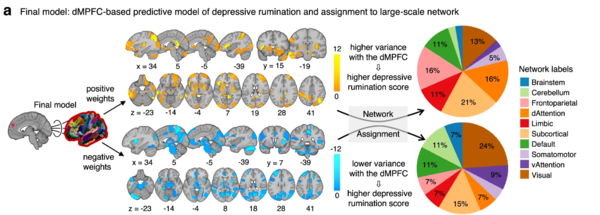Researchers at the Institute of Basic Science (IBS) said on Friday that they developed a technology to predict the tendency to focus on negative thoughts and feelings and also the level of depression in people diagnosed with depression.

Rumination occurs when a person becomes fixated on a thought or emotion. Excessive repetition of negative emotions can lead to mental health problems like depression and anxiety. Consequently, rumination has been recognized as a major risk factor for depression.
The study was led by Professor Woo Choong-wan, Associate Director at IBS Neuroscience Imaging Research Center, and Professor Tor D. Wager of Psychological and Brain Sciences at Dartmouth College.
Accordingly, they scanned participants' resting brains to measure the activity patterns of 20 regions of the default mode network and used machine learning to analyze the validity of the dynamic connectivity between each region.
The default mode network is a specific area of the brain that is activated when a person is at rest and not engaged in any cognitive activity. It is known to be involved in self-reflection, autobiographical memory, social and emotional processing, and creativity.
Previous studies have linked trait rumination to alterations in the default mode network, but specific predictive brain markers of rumination are lacking. For example, it is not known which regions of this default mode network functioned in relation to other brain regions.
The results showed that, within the default mode network, the dorsomedial prefrontal cortex, which is known to be associated with rumination, is also connected to the dorsolateral prefrontal cortex, a region associated with thoughts related to an individual's current state. Particularly, people with depression are known to have different brain connectivity centered in this region than healthy people.
The researchers found that the dynamic connectivity of the region was a key factor in predicting rumination, and based on this, they created a brain connectivity map that could predict rumination.
Accordingly, the team used the brain connectivity map to predict the ruminative tendencies of participants in domestic and international experiments, confirming the degree of rumination with participants of different ethnicities and languages.
The researchers also applied the brain connectivity map to patients with depression and found that it also predicted depression levels in patients with major depressive order.
"This study showed that the connectivity between the dorsolateral prefrontal cortex and other brain regions can be analyzed to predict how much an individual ruminates," said Professor Woo. "We also found that the connectivity between these brain regions is related to the level of depression which helps us understand the mechanisms of depression and provides clinical applications such as diagnosis and treatment of symptoms."
The results were published on June 15 in the international journal Nature Communications.

